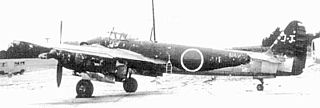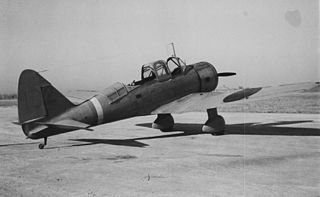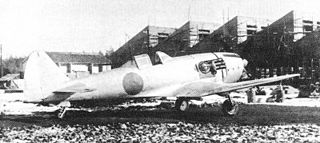
The Nakajima Ki-43 Hayabusa was a single-engine land-based tactical fighter used by the Imperial Japanese Army Air Force in World War II.

The Nakajima Ki-44 Shoki was a single-seat fighter-interceptor developed by the Nakajima Aircraft Company and operated by the Imperial Japanese Army from 1942 to 1945 during World War II. Its official designation is Army Type 2 Single-Seat Fighter (二式単座戦闘機) and its Allied reporting name was Tojo.

The Mitsubishi Ki-46 was a twin-engine reconnaissance aircraft used by the Imperial Japanese Army in World War II. Its Army Shiki designation was Type 100 Command Reconnaissance Aircraft (一〇〇式司令部偵察機); the Allied nickname was "Dinah".

The Mitsubishi Ki-67Hiryū was a twin-engine medium bomber produced by Mitsubishi and used by the Imperial Japanese Army Air Service and Imperial Japanese Navy Air Service in World War II. Its Army long designation was "Army Type 4 Heavy Bomber" (四式重爆撃機). Japanese Navy variants included the P2M and Q2M.

The Nakajima J5N was an abandoned Japanese prototype fighter aircraft of the World War II era. J5N was developed as twin-engine interceptor for countering attacks by Boeing B-29 Superfortress.

The Kawasaki Ki-45 Toryu was a two-seat, twin-engine fighter used by the Imperial Japanese Army in World War II. The army gave it the designation "Type 2 Two-Seat Fighter"; the Allied reporting name was "Nick".

The Nakajima Ki-27 was the main fighter aircraft used by the Imperial Japanese Army Air Force up until 1940. Its Allied nickname was "Nate", although it was called "Abdul" in the "China Burma India" (CBI) theater by many post war sources; Allied Intelligence had reserved that name for the nonexistent Mitsubishi Navy Type 97 fighter, expected to be the successor to the carrier-borne Type 96 with retractable landing gear and an enclosed cockpit.
The Kawasaki Ki-102 was a Japanese warplane of World War II. It was a twin-engine, two-seat, long-range heavy fighter developed to replace the Ki-45 Toryu. Three versions were planned: the Ki-102a day fighter, Ki-102b ground-attack and Ki-102c night fighter. This aircraft's Allied reporting name was "Randy".

The Tachikawa Ki-70 "Clara" was a high speed photo reconnaissance aircraft that was tested for the Japanese Air Force in prototype form but never entered production. The Ki-70 was the intended successor to the Mitsubishi Ki-46 but was difficult to handle and was slower than the Mitsubishi Ki-46. The Ki-70 was first flown in 1943 but was found unsatisfactory and the program was terminated. Three aircraft were built.
The Tachikawa Ki-94 was a single-seat fighter-Interceptor aircraft project undertaken by the Tachikawa Aircraft Company and to be operated by the Imperial Japanese Army. The project refers to two aircraft designs: the Ki-94-I and the Ki-94-II, both of which did not advance beyond the mock-up and prototype stage respectively.

The Tachikawa Ki-36 was a Japanese army co-operation aircraft of World War II. It was a two-seat, low-wing monoplane with a single piston engine and fixed, tailwheel-type undercarriage.

The Nakajima Ki-87 was a Japanese high-altitude fighter-interceptor of World War II. It was a single seat, exhaust-driven turbo-supercharged engined, low-wing monoplane with a conventional undercarriage.

The Tachikawa Ki-74 was a Japanese experimental long-range reconnaissance bomber of World War II. A twin-engine, mid-wing monoplane, it was developed for the Imperial Japanese Army Air Service but never deployed in combat. The Ki-74 was designed for high altitude operation with a pressurized cabin for its crew.

The Nakajima Ki-49 Donryu "Storm Dragon" was a twin-engine Japanese bomber aircraft of World War II. The type was designed to carry daylight bombing missions, without the protection of escort fighters. Consequently, while its official name, Army Type 100 Heavy Bomber, was accurate in regard to its formidable defensive armament and armor, these features also restricted the Ki 49 to payloads comparable to those of lighter medium bombers – the initial production variant could carry only 1,000 kg (2,200 lb) of bombs.

The Mitsubishi Ki-30 was a Japanese light bomber of World War II. It was a single-engine, mid-wing, cantilever monoplane of stressed-skin construction with a fixed tailwheel undercarriage and a long transparent cockpit canopy. The type had significance in being the first Japanese aircraft to be powered by a modern two-row radial engine. During the war, it was known by the Allies by the name Ann.

The Mitsubishi Ki-83 (キ83) was a Japanese experimental long range heavy fighter designed near the end of World War II. It did not reach production status.

The Mitsubishi Ki-2 was a light bomber built by Mitsubishi for the Imperial Japanese Army Air Service (IJAAS) in the 1930s. Its Allied nickname was "Louise". Despite its antiquated appearance, the Ki-2 was successfully used in Manchukuo and in North China during the early stages of the Second Sino-Japanese War, in areas where danger from enemy fighter aircraft was minimal. It was later used in a training role.
The Mitsubishi J4M Senden or Navy Experimental 17-Shi Otsu B Type Interceptor Fighter Senden, Allied reporting name Luke, was a Japanese World War II fighter aircraft proposed by Mitsubishi for use by the Imperial Japanese Navy. The J4M project did not proceed beyond the design stage.
The Mansyū Ki-98,, was a Japanese ground-attack aircraft proposed by Mansyū during World War II for use by the Imperial Japanese Army Air Force. The still unassembled components of the first prototype were deliberately destroyed before Japan surrendered.

The Tachikawa Ki-92 was an experimental Japanese heavy transport aircraft of World War II. It was a low-wing monoplane with a pressurized fuselage, twin piston engines and a tailwheel undercarriage.
















